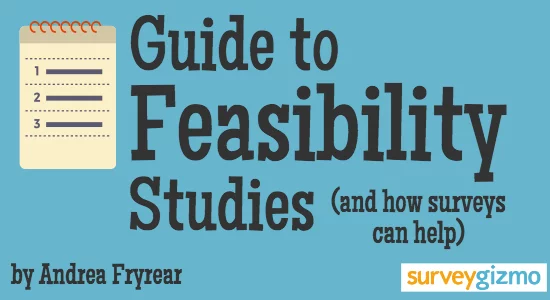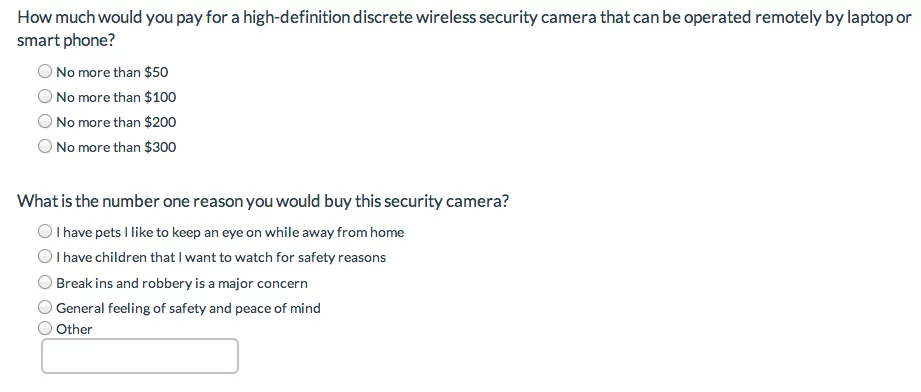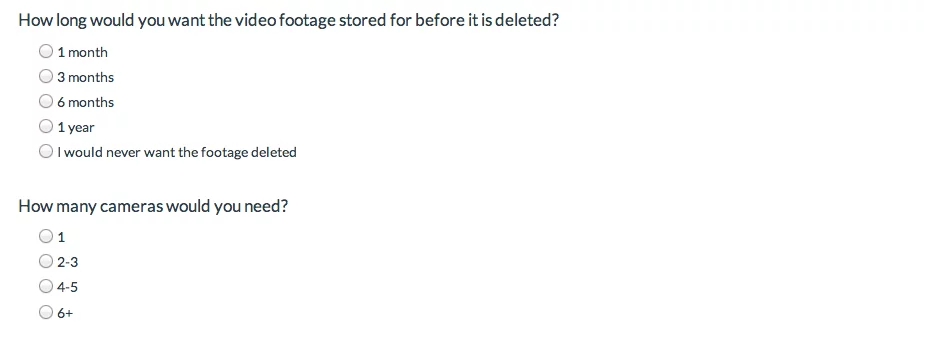
What is a Feasibility Study?
Feasibility studies are designed to answer a very simple question: Is this idea feasible?
While simple on the surface, finding an answer to that question often involves considerable investigative energy into many different areas.
From existing competitors to financial options to technical and production considerations, there are dozens of factors affecting the feasibility of any new venture.
In this guide we’ll explore the appropriate times to run a feasibility study, what your final report on your findings should include, who’s best suited to run a this analysis, and how surveys can help you answer some of the most pressing feasibility questions.
The Right Time to Conduct a Feasibility Study
Regardless of your confidence in your new product or your brilliant idea, it’s always a good idea to investigate its real world feasibility before you invest too much time or money.
All new businesses should conduct a feasibility study before starting production and/or going to market, and most established companies conduct them in advance of new product launches.
These types of reports can also offer the hard data necessary to make hard decisions about the future direction of a company or product. If you have internal disagreement about the next steps for your marketing, development, or expansion, a feasibility study can settle it with unbiased information.
Ready to Factor in Feasibility?
When You Don’t Need a Feasibility Study
In order to save money and time, and often to simply go to market faster, entrepreneurs may choose to forego running a feasibility study. This can pay off with being the first into an emerging market, or it can backfire if a new company encounters unexpected obstacles.
Some common reasons that you might want to bypass this type of exploration:
- Founders or entrepreneurs know the new venture is feasible based on their own experience or on a similar business model that is currently successful.
- You’re still confident in the results from your most recent study and don’t think there have been enough changes to warrant a new one.
- The costs in both money and time prohibit completing a full feasibility analysis.
Key Components of a Feasibility Study
A feasibility study can cover a wide variety of topics that might have an impact on your new venture, but most fall into one or more of these categories.
Technical
Do you have proprietary technology on which your launch depends? Might new technology emerge that would affect your product?
Economic
Consider existing and future economic conditions that might impact your market’s ability or willingness to purchase your product or service, along with any sources of initial cash flow.
Legal
This is where to investigate existing patents, copyrights, or other restrictions that might affect your idea.
Operations
Do you need a store front? Employees? Letterhead? Make note of the costs of all your operating costs.
Scheduling
If you need to release your product at a particular time of year, or before an event, make sure to take these restrictions into account.
Marketability
Marketability is an extremely broad category that could include:
- Competitors
- Level of demand
- Unoccupied niches
- Target markets, including specific demographics and purchasing habits
- Physical vs. online marketing
How to Get Data Resulting from a Feasibility Study
By far the quickest way to get going is to hire a consultant to run the study from start to finish and report on their findings. While tempting, this option is probably out of the question for all but the best-funded startups.
You’ll also need to include the costs of the feasibility report itself in your economic factors, and doing so might push businesses that were just barely profitable in their early stages into the red.
On the other hand, if you barrel forward without data you risk losing initial capital investments. Many investors will also refuse to entertain your proposals without this type of information, so it may be a non-negotiable expense.
The good news is that with secondary market research data widely available and lots of handy survey templates like this one out there, you can do a lot of the leg work yourself and reduce the overhead while still getting great feasibility data.
Using Surveys in a Feasibility Study to Understand Your Marketability
You need to reach out to your target market to learn as much as possible about the people who you hope are going to be paying for your product or service, and surveys are by far the best way to do this.
Running a survey of your potential customers might even reveal dissatisfaction with particular products or features that you could exploit, changing your feasibility prospects from questionable to positive.
Sample Format for a Feasibility Study Report
Once you have your data, you need to collect it into an easy-to-ready, digestible document that clearly demonstrates how your idea will some day rule the world (or is at least initially doable).
Feasibility study reports should include at least these sections, though you may need to add additional details to cover your particular niche or idea:
Executive Summary
The high level points and overview of the data you’ll be exploring later. Cover all the most important details, because lots of readers won’t get beyond this part.
Defining Your Idea
Here’s where you go into detail about your product, service, company, app, or whatever you’re investigating. Differentiating factors and unique value proposition belong here, as do any existing hurdles like products with similar names or functionality.
Market Analysis
All your primary and secondary survey data goes on display in this section, from competitive analysis to buyer behavior to market segmentation. The existence of strong markets is vital to your success, so many reports spend a lot of time on this section.
Profitability and Operating Costs
If you can estimate when you’ll likely be turning a profit, do so in this section. You should also include details about what it will cost to run your operation on a day to day basis, and what sort of margins you can expect in the short, medium, and long terms.
Conclusions and Recommendations
So…is it feasible? Pull all your data together to answer the big question.
Example Questions from a Feasibility Survey
If you were investigating the feasibility of a new wireless security camera, you might ask different segments of your audience questions like these to clarify their buying habits and position yourself in the market.



Is a Feasibility Study…Feasible?
Tackling a full blown feasibility study can feel daunting, but once you’ve invested the time for designing, collecting, analyzing, and reporting on all the data it can perform a wide variety of functions in a growing business.
Whether it’s a presentation to venture capital firms, writing a professional business plan, or guiding your early marketing efforts, this data will be invaluable. Take the time to do it right, and feasibility studies will become not just feasible, but maybe even enjoyable.